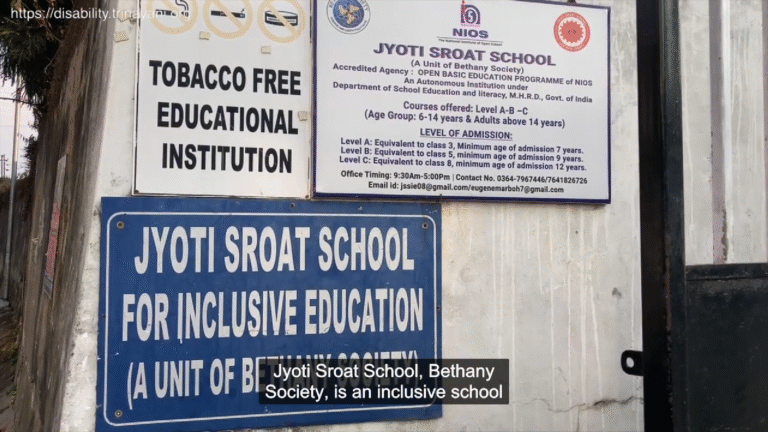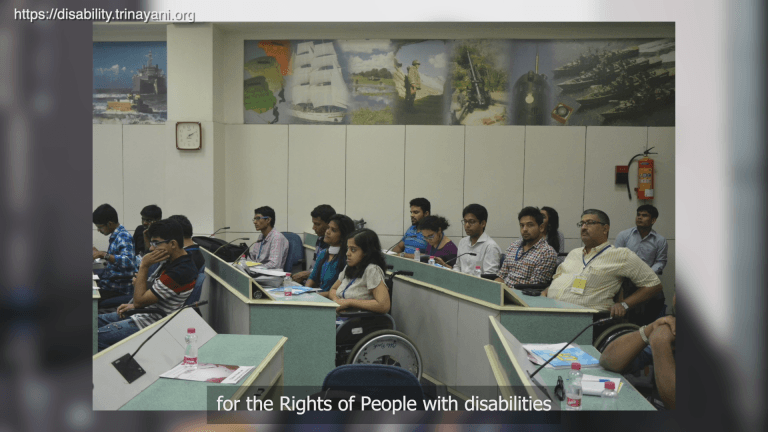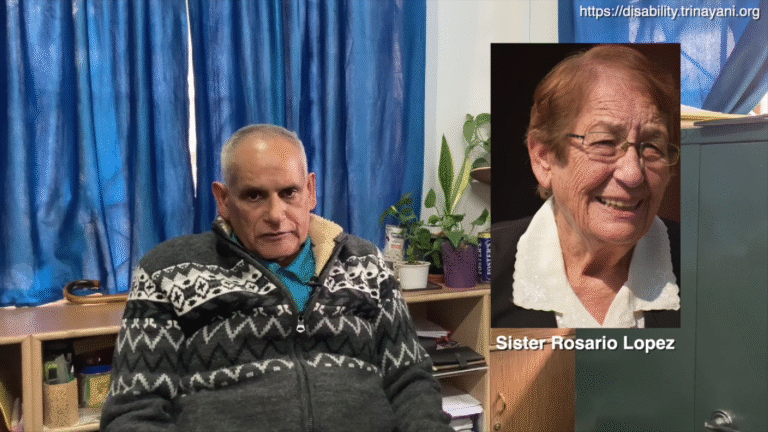SARVAM – Inclusive Education
This film on Sarvam brings to us a new way of thinking about inclusive education! Sarvam means “complete” and “all-encompassing”.
Swati Morzaria , co-founder of Sarvam shares how learning spaces can be transformed into supportive environments. The school starts each day with yoga to boost energy and focus, helping children prepare for their day ahead. The film highlights the importance of community and teamwork, showing how teachers, parents and children work together to create an inclusive environment.
How do you perceive Inclusive Education at Sarvam?
So, Sarvam means complete.
It is everything, it is all encompassing.
That’s the meaning of the word Sarvam.
When we talk about Inclusive Education, we’re always focused on um the dynamics of children, but at Sarvam we just don’t focus on the dynamics of the children, it’s no uh, you know, having five children who are neurotypical and two children who are neurodivergent, where they have some kind of condition, they have a disability, it’s not just about that.
Why is it not just about that?
Because five neurotypical children will still not have the knowledge to handle two neurodivergent children or two children who have disabilities.
The whole point of inclusion, as we know it today, is because we want children with disabilities to learn from the typical children.
But if the typical children don’t know what they have to do, then the whole point of inclusion is gone.
So, we take inclusion to the next level at Sarvam.
We include everybody here.
We invite the parents to be shadows or teaching assistants.
We invite the mothers, if they are free.
Most times we insist that one parent is the TA, (teachers assistant) at least for the first one year.
Uh because the environment that is at school has to be the environment at home.
The two environments don’t match.
The two environments don’t match because a parent or an individual who is dealing with a child with different abilities or disabilities, they don’t know themselves how to handle this child.
When they come to a professional place like ours, they see, they learn, they copy, they…the gaps in their understanding about what a disability is or what a condition is, is closed.
When these gaps get closed, the environments become the same and everything is environment.
Environment for these children is first, people.
It’s not the infrastructure.
So if people are the environment, how can a person or a human being, who’s the environment for a child with disability make themselves better, become better infrastructure?
Become that point or become that being, that human being, how they have to be, that can actually make progress in the life of this human being with disability.
We use this model called the Consciousness Focussed Education Model here.
My husband who is the Co-Founder, Mr Natarajan, he has studied this uh system from the United States, from the Maharashi International University.
So uh he has mentored me in this methodology and we apply this method.
We use our ancient wisdom of yoga and ayurveda, not first on the children but first on the human being who is handling the child.
Because these two systems, they are so solid in their foundation of human development, the theories from these systems are so uh full in what we want to convey to the parents, to the shadow teachers, to any teacher that is an environment for this child.
So, we use these models to uh make the human who is handling a child with disability better.
Now, it, it should not be taken as an offense, it can’t be taken uh personally as well, by parents, but there is a need, there is a need for training.
What is the method you will use for training, to become a better human being?
Because only a better human being who’s a human being at a higher level can handle somebody with disabilities, because you first need to work with your emotions.
What you are seeing is the world’s view of imperfection.
There is, you know, there is an imbalance.
This is not perfect.
But, at Sarvam what we believe is everything is perfect, everything is normal.
There is no normal or abnormal, and you have to learn as a parent to see that first, and the Consciousness Focused Education Model helps you to see exactly that.
That this is not imperfection, this is okay, this is something normal, there is a condition, I need to work on my ability to look at it as normal.
If I can reach there, then I can handle this, I can become the environment and I can become the infrastructure.
So, yoga and ayurveda are the two tools mainly that help us to do this, and then of course, we have, you know, the other things that all such schools have.
English, Math, Language, Life Skills, tools and techniques from the techn…technological world as well, which help us to impart education for these children.
What age group of children does your school serve, and what does a typical day at Sarvam look like?
So the age group that we have here is uh from 3 years to 12 years mainly, the oldest is a girl and we’re doing third standard for her currently.
We have been, uh you know, we are a 4-year old school, we were a typical school before.
In the last four years, we have had, you know, children coming in, taking admission and moving at every level.
So the highest level that we have now is grade three.
We’re hoping to move her to grade four next year and then move on uh from there.
A typical day starts at 9 o’clock at uh Sarvam, with yoga, with uh, you know, yoga includes asanas, some breath work, some chanting, because the main problem with these children is blood circulation.
And we all know that yoga is a tool for improving blood circulation, thereby improving your breath and thereby helping you to retain energy.
So, yoga is everything, yoga is movement at Sarvam, and movement is very important for these children.
So, we apply yoga therapy at Sarvam.
It’s…it’s like how you have occupational therapy, we use yoga therapy and yoga therapy is everything at Sarvam.
We apply and we infuse yoga therapy at all levels.
So I am a certified yoga assistant therapist.
Uh my husband and Co-Founder is an international yoga therapist, certified internationally and uh also a Yoga Chikitsacharya.
So, he has mentored me and I’m using uh yoga therapy that has been, you know, uh given to me by my husband.
He’s…he’s still teaching me, I apply it at the student level through the teachers and through the mothers.
Could you provide details on the class distinctions and how education is delivered to children with and without disabilities enrolled at Sarvam?
Uh we have three uh divisions or we have three sections where we have the three to eight year old, depending on the condition in one class and then the eight to ten year old or…or, you know, it can be just a group of six to eight year olds.
It depends on the condition but mainly we have three classes, three classrooms and everything except academics is done together.
Now uh I want to just elaborate this with a very simple example.
We do this because in the real world, we’re not actually kept in age groups.
We’re not working with, you know, 20 year olds in one group or 30 year olds in one group or 50 year olds in one group.
Everybody works together, irrespective of their age.
And you’re supposed to have the same skill set, you’re supposed to be independent in the same manner.
So, uh a typical day is filled with activities that is targeted at making the child independent.
And those activities need not be done typically, you know, in a different way for a 4-year-old, in a different way for a 6-year old or a 12-year old, everybody does it together.
Whatever level you are at, you just pick it up from there and you keep improving in that particular activity.
Only the subjects, English, Math and Science are done individually, where we have separate teachers.
The teaching assistant, she takes the guidance from the lead teacher and she moves on with her lesson.
The technique is given by the lead teacher, that this is the technique I want you to use.
In some cases, the mother is the shadow teacher or the teaching assistant and it becomes easier over there, uh development in academics is faster.
The ratio of uh typical children to neurodivergent children is about 75:25, mostly.
The…the disabilities uh range from autism, mild-severe, uh, you know, medium to down syndrome to Global developmental delay, cerebral palsy.
We have dyslexia, we have uh learning difficulties, uh ADHD, all kinds, in the 30 children.
See, I am a curriculum specialist and I’ve done my curriculum specialization from Cambridge and British Counseling.
So, I have learned to integrate all the curriculums across the world and then do uh, you know, just take out whatever is child specific and give that to the child.
What qualities are important for a teacher working with children with disabilities?
A teacher who’s handling children with disabilities or special needs, first of all, should love herself or himself.
So, know yourself, accept yourself, understand who you are first, uh, you know, why you are with a child with disabilities. That is a mandate.
The second thing is, you have to understand the meaning of love because more than anything else these children need love, they understand empathy, they understand the meaning of love and that is what they expect in the environment, in the infrastructure that the human being is providing for them, love.
Third, basic knowledge of reading and writing, correct reading and writing.
So, you have to be having grammatically correct knowledge of the language in which you are teaching the child, because this child does not understand grammar.
Grammar is a high level concept for these children, but if you speak grammatically correct language, the medium of instruction, then half the problem is over, because a child will at least imbibe correct language through the method of rote learning, because they rote learn, these children.
That is the third thing.
The fourth thing is any one skill, you know, either uh, I would say, vocational skill, it can either be gardening, cooking, it can be, you know, uh drawing, painting, it could be anything, because at Sarvam we strive to use a skill that a teacher is having or that a, you know, that an employee comes with at Sarvam, to uh transfer that skill to a child who can uh understand that particular skill, who has the uh ability to develop that skill and make that as a medium of employment.
So that is very important in this uh teacher.
Five is the ability to be a team worker, because if you can’t work in a team, this is teamwork.
A child with different abilities or disabilities cannot, you know, depend on one-on-one teaching all the time, should not depend on one-on-one teaching against what everybody else tells; that this child, only one-on-one works but at Sarvam we tend to prove the opposite.
Even with the children with different needs, you can work with a team and for the last four years this is what we’ve been striving to do.
So if you can’t be a team worker, if you can’t listen to instructions from other people, uh it’s gonna be difficult because nobody knows in reality, in the world, how to deal with them in the perfect way.
It’s a learning process for everybody.
Even for a person like me, who has been dealing with them for the last ten years, or say 17 years, because I have a child, uh, you know, who has different needs, I am still in the process and I need support from other people.
I am not going to say that I am everything for this child or I can teach everything to this child because my skill set is limited.
My ability to communicate is limited.
I can’t teach everything to the child, so, assuming that a child with disabilities can only work with one person and doesn’t require a team is not true.
And then of course, you know, you have to have some subject knowledge.
If you’re aspiring to teach uh, you know, English, what you need to teach English to a child with disabilities is the understanding that you are teaching a process to the child, you’re not just teaching language because these children thrive on pr…uh processes.
If you can’t teach English in a systematic way, like, you know, if you’re teaching nouns, you need to have a step-by-step procedure for it.
So, even before you strive to teach English knowledge, you should understand what a standard operating procedure.
You should understand what is an SOP.
You should understand that if you skip one step in the teaching of something as simple as nouns, it’s not going to work for this child.
So, I would say understanding of what is a process, what is process knowledge and how to transfer process knowledge is very important.
Understanding what is the meaning, true meaning of structure is very important.
Understanding what is order…If you have to teach nouns, it has to be taught in an order to these children.
So, one of the most important things, that, you know, uh teachers can focus on is learning, unlearning and relearning, that is a continuous process, because every child is different.
There’s a particular order.
Sometimes you have to relearn something, sometimes you have to unlearn something, and you have to learn again.
So, learning, unlearning and relearning is a continuous process at Sarvam and that can be anything.
That can be, like I spoke, uh you know, just 5 minutes back, about how you teach nouns.
So, teaching nouns, you can teach that uh to a down syndrome child in a different way, you can teach that to an autistic child in a different way and to a dyslexic child in a different way.
So, the minute a special educator who comes here, again cannot apply the same method of teaching nouns to all of these three children.
But what they come here is with, ‘okay now I have this, I’m an inclusive educator or I’m a teacher or I’m an assistant who can help these children’, but what I see is that they apply the same method for all these three children and I have to always call them, sit them down and do a detailed talk to them about why they can’t apply one method of teaching nouns to all of these three children because they are again three different children with three different conditions, because that is what keeps you grounded.
You need to be humble.
You need to uh be filled with that humility that I can learn more.
When you don’t have that curiosity or that…that need to learn and you say, ‘Okay I’ve learned everything’, then I think you just cannot move on, you become stagnant.
So the first and foremost thing I would say, I mean, you know, is this, that you accept that I have to keep learning.
ADHD, autism, ayurveda, Cerebral Palsy, consciousness focused education, curriculum integration, disability awareness, Down Syndrome, dyslexia, environment adaptation, inclusive education, independence training, neurodivergent, neurotypical, parent involvement, skill development, special needs, teaching assistants, team approach, yoga therapy
Dive Deeper: More on Disability
Learn about the most common inquiries surrounding disability, education, legislation, accessibility, employment and other sectors related to disability.


Playlist
Access & Inclusion


Playlist
Adaptive Sports


Playlist
Alternative Communication Methods


Playlist
Autism & Neurodiversity


Playlist
Blindness & Adaptations


Playlist






